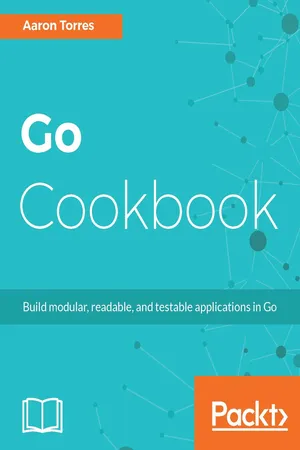
Go Cookbook
Aaron Torres
- 400 Seiten
- English
- ePUB (handyfreundlich)
- Über iOS und Android verfügbar
Go Cookbook
Aaron Torres
Über dieses Buch
Bridge the gap between basic understanding of Go and use of its advanced featuresAbout This Book• Discover a number of recipes and approaches to develop modern back-end applications• Put to use the best practices to combine the recipes for sophisticated parallel tools• This book is based on Go 1.8, which is the latest versionWho This Book Is ForThis book is for web developers, programmers, and enterprise developers. Basic knowledge of the Go language is assumed. Experience with back-end application development is not necessary, but may help understand the motivation behind some of the recipes.What You Will Learn• Test your application using advanced testing methodologies• Develop an awareness of application structures, interface design, and tooling• Create strategies for third-party packages, dependencies, and vendoring• Get to know tricks on treating data such as collections• Handle errors and cleanly pass them along to calling functions• Wrap dependencies in interfaces for ease of portability and testing• Explore reactive programming design patterns in GoIn DetailGo (a.k.a. Golang) is a statically-typed programming language first developed at Google. It is derived from C with additional features such as garbage collection, type safety, dynamic-typing capabilities, additional built-in types, and a large standard library.This book takes off where basic tutorials on the language leave off. You can immediately put into practice some of the more advanced concepts and libraries offered by the language while avoiding some of the common mistakes for new Go developers.The book covers basic type and error handling. It explores applications that interact with users, such as websites, command-line tools, or via the file system. It demonstrates how to handle advanced topics such as parallelism, distributed systems, and performance tuning. Lastly, it finishes with reactive and serverless programming in Go.Style and approachThis guide is a handy reference for developers to quickly look up Go development patterns. It is a companion to other resources and a reference that will be useful long after reading it through the first time. Each recipe includes working, simple, and tested code that can be used as a reference or foundation for your own applications.
Häufig gestellte Fragen
Information
Microservices for Applications in Go
- Working with web handlers, requests, and ResponseWriters
- Using structs and closures for stateful handlers
- Validating input for Go structs and user inputs
- Rendering and content negotiation
- Implementing and using middleware
- Building a reverse proxy application
- Exporting GRPC as a JSON API
Introduction
- https://github.com/urfave/negroni
- https://github.com/gin-gonic/gin
- https://github.com/labstack/echo
- http://www.gorillatoolkit.org/
- https://github.com/julienschmidt/httprouter
Working with web handlers, requests, and ResponseWriters
// HandlerFunc implements the Handler interface
type HandlerFunc func(http.ResponseWriter, *http.Request)
type Handler interface {
ServeHTTP(http.ResponseWriter, *http.Request)
}
Getting ready
- Download and install Go on your operating system from https://golang.org/doc/install, and configure your GOPATH environment variable.
- Open a terminal/console application.
- Navigate to your GOPATH/src and create a project directory, such as $GOPATH/src/github.com/yourusername/customrepo.
- Optionally, install the latest tested version of the code using the go get github.com/agtorre/go-cookbook/ command.
- Install the curl command from https://curl.haxx.se/download.html.
How to do it...
- From your terminal/console application, create and navigate to the chapter7/handlers directory.
- Copy tests from https://github.com/agtorre/go-cookbook/tree/master/chapter7/handlers or use this as an exercise to write some of your own code.
- Create a file called get.go with the following contents:
package handlers
import (
"fmt"
"net/http"
)
// HelloHandler takes a GET parameter "name" and responds
// with Hello <name>! in plaintext
func HelloHandler(w http.ResponseWriter, r *http.Request) {
w.Header().Set("Content-Type", "text/plain")
if r.Method != http.MethodGet {
w.WriteHeader(http.StatusMethodNotAllowed)
return
}
name := r.URL.Query().Get("name")
w.WriteHeader(http.StatusOK)
w.Write([]byte(fmt.Sprintf("Hello %s!", name)))
}
- Create a file called post.go with the following contents:
package handlers
import (
"encoding/json"
"net/http"
)
// GreetingResponse is the JSON Response that
// GreetingHandler returns
type GreetingResponse struct {
Payload struct {
Greeting string `json:"greeting,omitempty"`
Name string `json:"name,omitempty"`
Error string `json:"error,omitempty"`
} `json:"payload"`
Successful bool `json:"successful"`
}
// GreetingHandler returns a GreetingResponse which either has
// errors or a useful payload
func GreetingHandler(w http.ResponseWriter, r *http.Request) {
w.Header().Set("Content-Type", "application/json")
if r.Method != http.MethodPost {
w.WriteHeader(http.StatusMethodNotAllowed)
return
}
var gr GreetingResponse
if err := r.ParseForm(); err != nil {
gr.Payload.Error = "bad request"
if payload, err := json.Marshal(gr); err == nil {
w.Write(payload)
}
}
name := r.FormValue("name")
greeting := r.FormValue("greeting")
w.WriteHeader(http.StatusOK)
gr.Successful = true
gr.Payload.Name = name
gr.Payload.Greeting = greeting
if payload, err := json.Marshal(gr); err == nil {
w.Write(payload)
}
}
- Create a new directory named example and navigate to it.
- Create a file called main.go with the following contents; be sure to modify the handlers import to use the path you set up in step 2:
package main
import (
"fmt"
"net/http"
"github.com/agtorre/go-cookbook/chapter7/handlers"
)
func main() {
http.HandleFunc("/name", handlers.HelloHandler)
http.HandleFunc("/greeting", handlers.GreetingHandler)
fmt.Println("Listening on port :3333")
err := http.ListenAn...